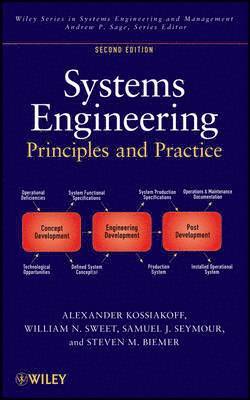
- Format
- Inbunden (Hardback)
- Språk
- Engelska
- Antal sidor
- 558
- Utgivningsdatum
- 2011-04-19
- Upplaga
- 2nd Edition
- Förlag
- John Wiley & Sons Inc
- Illustrationer
- Illustrations
- Dimensioner
- 206 x 162 x 37 mm
- Vikt
- Antal komponenter
- 1
- ISBN
- 9780470405482
- 990 g
Systems Engineering Principles and Practice
Kundrecensioner
Recensioner i media
"Aimed at advanced undergraduate and postgraduate students, this textbook is intended as an introduction to the developmetn and acquisition of complex technical systems ... The second edition is intended to offer expansion, integration and clarification to maintain relevance and currency." (Times Higher Education Supplement {Texbook Guide}, 3 November 2011) "The book is very readable and gives a particularly good grounding in the subject of systems engineering. It is therefore a valuable volume for any electronics engineering student, practising engineer, or as a reference for a company designing any form of equipment needing a systems engineering approach." (Radio-electronics.com, 1 October 2011)
Övrig information
Alexander Kossiakoff (deceased) was a director and chief scientist of the Johns Hopkins University Applied Physics Laboratory, as well as program chair of the MS program in systems engineering and technical management at JHU Whiting School of Engineering. William N. Sweet, now retired, was associate department head of the Fleet Systems Department at the Johns Hopkins University Applied Physics Laboratory. Samuel J. Seymour is the systems engineering vice chair at the Johns Hopkins University Whiting School of Engineering. He served under Professor Kossiakoff for more than twenty-five years. Steven M. Biemer is an instructor at the Johns Hopkins University Whiting School of Engineering. He assisted Professor Kossiakoff in developing the first edition of this book.
Innehållsförteckning
List of Illustrations. List of Tables. Preface to the Second Edition. Preface to the First Edition. Part I Foundations of System Engineering. 1 Systems Engineering and the World of Modern Systems. 2 Systems Engineering Landscape. 3 Structure of Complex Systems. 4 The System Development Process. 5 Systems Engineering Management. Part II Concept Development Stage. 6 Needs Analysis. 7 Concept Exploration. 8 Concept Definition. 9 Decision Analysis and Support. Part III Engineering Development Stage. 10 Advanced Development. 11 Software Systems Engineering. 12 Engineering Design. 13 Integration and Evaluation. Part IV Postevelopment Stage. 14 Production. 15 Operation and Support. Index.
Du kanske gillar
-
Nexus
Yuval Noah Harari
Häftad -
Orbital
Samantha Harvey
Häftad
